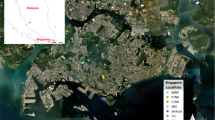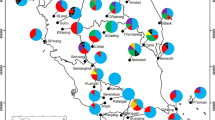Abstract
Knowledge of the amount and patterns of genetic variation within and among populations of mangrove trees is essential for devising optimum genetic management strategies for their conservation and sustainable utilization. Ceriops tagal is a widespread viviparous mangrove. Genetic diversity in the species was examined with inter-simple sequence repeat (ISSR). Nine natural populations were collected from Thailand and China. The estimates of genetic variation were extremely low (HT = 0.0179 ± 0.005, HS = 0.0084 ± 0.001), and only 47% of the total gene diversity was maintained within populations (GST = 0.529). The eastern coastal populations of Thailand were more similar to populations from China than to populations from the western coastline of Thailand. A high level of Nei's genetic identity exists between populations of C. tagal (I = 0.989), suggesting their common ancestry. The low levels of genetic diversity in the species may result from a series of genetic bottlenecks during several glacial epochs.
Similar content being viewed by others
References
Aksornkoae, S. 1993. Ecology and Management of Mangroves. IUCN, Bangkok, Thailand.
Brown, J.H. and Lomolino, M.V. 1998. Biogeography. 2ed. Sinauer Associates, Inc. Sunderland, Massachusetts. 209
Clark, P.J. 1992. Predispersal mortality and fecundity in the grey mangrove (Avicennia marina) in southeastern Australia. Aust. J. Ecol. 17: 161–168.
Doyle, J. 1991. DNA protocols for plants. In: Hewitt, G.M. et al. (eds.), Molecular Techniques in Taxonomy. pp. 283–286. Springer-Verlag, Berlin Heidelberg.
Duke, N.C. 1992. Mangrove floristics and biogeography. In: Robertson, A. and Alongi, D. (eds.), Tropical Mangrove Ecosystem. pp. 63–100. American Geographical Union, Washington, DC.
Duke, N.C. 1995. Genetic diversity, distributional barriers and rafting continents–more thoughts on the evolution of mangroves. Hydrobiologia 295: 167–181.
Duke, N.C., Benzie, J.A.H, Goodall, J.A. and Ballment, E.R. 1998. Genetic structure and evolution of species in the mangrove genus Avicennia (Avicenniaceae) in the Indo-West Pacific. Evolution 52: 1612–1626.
Ellison, J.C. 1996. Pollen evidence of late Holocene mangrove development in Bermuda. Gl. Ecol. Biogeogr. Lett. 5: 315–326.
Esselman, E.J., Jianqiang, L., Crawford, D.J., Windus, J.L. and Wolfe, A.D. 1999. Clonal diversity in the rare Calamagrostis porteri ssp. insperata (Poaceae): comparative results for allozymes and random amplified polymorphic DNA (RAPD) and intersimple sequence repeat (ISSR) markers. Mol. Ecol. 8: 443–451.
Fang, D.Q., Roose, M.L., Krueger, R.R. and Federici, C.T. 1997. Fingerprinting trifoliate orange germ plasm accessions with isozymes, RFLPs, and inter-simple sequence repeat markers. Theor. Appl. Genet. 95: 211–219.
Fritsch, P. and Rieseberg, L.H. 1996. The use of Random Amplified Polymorphic DNA (RAPD) in conservation genetics. In: Smith, T.B. and Wayne, R.K. (eds.), Molecular Genetic Approaches in Conservation. pp. 54–73. Oxford University Press, New York.
Godwin, I.D., Aitken, E.A.B. and Smith, L.W. 1997. Application of inter simple sequence repeat (ISSR) markers to plant genetics. Electrophoresis 18: 1524–1528.
Goodall, J.A. and Stoddart, J.A. 1989. Techniques for the electrophoresis of mangrove tissue. Aq. Bot. 35: 197–207.
Gupta, M., Chyi, Y-S., Romero-Severson, J. and Owen, J.L. 1994. Amplification of DNA markers from evolutionarily diverse genomes using single primers of simple-sequence repeats. Theor. Appl. Genet. 89: 998–1006.
Hamrick, J.L. and Godt, M.J.W. 1989. Allozyme diversity in plant species. In: Brown, A.H.D., Clegg, M.T., Kahler, A.L. and Weir, B.S. (eds.), Plant Population Genetics, Breeding and Genetic Resources. pp. 43–63. Sinauer, Sunderland, MA.
Hamrick, J.L., Godt, M.J.W., Murawski, D.A. and Loveless, M.D. 1991. Correlations between species and allozyme diversity: implications for conservation biology. In: Falk, D.A. and Holsinger, K.E. (eds.), Genetics and Conservation of Rare Plants. pp. 75–86. Oxford University Press, New York.
Hamrick, J.L. and Godt, M.J.W. 1996. Conservation genetics of endemic plant species. In: Avise, J.C. and Hamrick, J.L. (eds.), Conservation Genetics: Case Histories from Nature. pp. 281–304. Chapman & Hall, New York.
Huang, S., Chen, Y.J. and Havanond, S. 1999. Patterns of genetic variation of Ceriops tagal in Ranong and Eastern Malay Peninsula. Paper presented at Ecotone VIII. May 23–29, 1999. Ranong, Thailand.
Lakshimi, M., Rajalakshmi, S., Parani, M., Anuratha, C.S. and Parida, A. 1997. Molecular phylogeny of mangroves I. Use of molecular markers in assessing the intraspecific genetic variability in the mangrove species Acanthus ilicifolius Linn. (Acanthaceae). Theor. Appl. Genet. 94: 1121–1127.
McGuinness, K.A. 1997. Dispersal, establishment and survival of Ceriops tagal propagules in a north Australian mangrove forest. Oecologia (Berlin) 109: 80–87.
Nagaoka, T. and Ogihara, Y. 1997. Applicability of inter-simple sequence repeat polymorphisms in wheat for use as DNA markers in comparison to RFLP and RAPD markers. Theor. Appl. Genet. 94: 597–602.
Nei, M. 1972. Genetic distance between populations. Amer. Natur. 106: 282–292.
Nei, M. 1973. Analysis of gene diversity in subdivided populations. Proc. Nat. Acad. Sci. USA 70: 3321–3323.
Parani, M., Lakshmi, M., Elango, S., Ram, N., Anuratha, C.S. and Parida, A. 1997. Molecular phylogeny of mangroves II. Intraand inter-specific variation in Avicennia revealed by RAPD and RFLP markers. Genome 40: 487–495.
Ratnaparkhe, M.B., Tekeoglu, M. and Muehlbauer, F.J. 1998. Intersimple sequence repeat (ISSR) polymorphisms are useful for finding markers associated with disease resistance gene clusters. Theor. Appl. Genet. 97: 515–519.
Sherrod, C.L. and McMillan, C. 1985. The distributional history and ecology of mangrove vegetation along the northern Gulf of Mexico coastal region. Contr. Mar. Sci. 28: 127–140.
Smith, J.F. and Pham, T.V. 1996. Genetic diversity of the narrow endemic Allium aaseae (Alliaceae). Amer. J. Bot. 83: 717–726.
Sun, M., Wong, K.C. and Lee, J.S.Y. 1998. Reproductive biology and population genetic structure of Kandelia candel (Rhizophoraceae), a viviparous mangrove species. Amer. J. Bot. 85: 1631–1637.
Sun, X.J. and Li, X. 1999. A pollen record of the last 37 ka in deep sea core 17940 from the northern slope of the south China Sea. Mar. Geol. 156: 227–241.
Tomlinson, P.B. 1986. The Botany of Mangroves. Cambridge University Press, Cambridge.
Umitsu, M., Pramojanee, P., Ohira, A. and Kawase, K. 1999. Late Holocene mangrove habitat and evolution of coastal lowlands in southern Thailand. Tropics 8: 317–328.
Willams, J.G., Kubelik, A.E., Livak, K.J., Rafalski, J.A. and Tingey, S.V. 1990. DNA polymorphisms amplified by arbitrary primers are useful as genetic markers. Nucl. Acids Res. 18: 6531–6535.
Wolfe, A.D. and Liston, A. 1998. Contributions of PCR-based methods to plant systematics and evolutionary biology. In: Soltis, D.E., Soltis, P.S. and Doyle, J.J. (eds.), Plant Molecular Systematics II. pp. 43–86. Chapman Hall, New York.
Yamazaki, T. 1998. Molecular polymorphism and population structure of several tropical tree species in southeast Asia. Amer. J. Bot. 85: 62 (Abstract).
Yeh, F.C., Yang, R.C., Boyle, T.B.J., Ye, Z.H. and Mao, J.X. 1997. POPGENE, the user-friendly shareware for population genetic analysis. Mol. Biol. Biotech. Center, University of Alberta, Canada.
Zietkiewicz, E., Rafalski, A. and Labuda, D. 1994. Genome fingerprinting by simple sequence repeat (SSR)-anchored polymerase chain reaction amplification. Genomics 20: 176–183.
Author information
Authors and Affiliations
Rights and permissions
About this article
Cite this article
Ge, XJ., Sun, M. Population genetic structure of Ceriops tagal (Rhizophoraceae) in Thailand and China. Wetlands Ecology and Management 9, 213–219 (2001). https://doi.org/10.1023/A:1011156707160
Issue Date:
DOI: https://doi.org/10.1023/A:1011156707160




